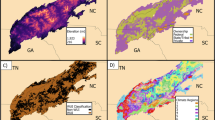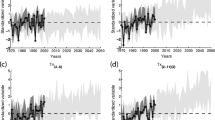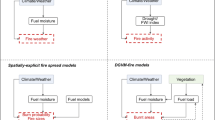Abstract
Seasonal changes in the climatic potential for very large wildfires (VLWF ≥ 50,000 ac ~ 20,234 ha) across the western contiguous United States are projected over the 21st century using generalized linear models and downscaled climate projections for two representative concentration pathways (RCPs). Significant (p ≤ 0.05) increases in VLWF probability for climate of the mid-21st century (2031–2060) relative to contemporary climate are found, for both RCP 4.5 and 8.5. The largest differences are in the Eastern Great Basin, Northern Rockies, Pacific Northwest, Rocky Mountains, and Southwest. Changes in seasonality and frequency of VLWFs d7epend on changes in the future climate space. For example, flammability-limited areas such as the Pacific Northwest show that (with high model agreement) the frequency of weeks with VLWFs in a given year is 2–2.7 more likely. However, frequency of weeks with at least one VLWF in fuel-limited systems like the Western Great Basin is 1.3 times more likely (with low model agreement). Thus, areas where fire is directly associated with hot and dry climate, as opposed to experiencing lagged effects from previous years, experience more change in the likelihood of VLWF in future projections. The results provide a quantitative foundation for management to mitigate the effects of VLWFs.



Similar content being viewed by others
References
Abatzoglou JT, Brown TJ (2012) A comparison of statistical downscaling methods suited for wildfire applications. Int J Climatol 32(5):772–780
Abatzoglou JT (2013) Development of gridded surface meteorological data for ecological applications and modelling. Int J Climatol 33(1):121–131
Abatzoglou JT, Kolden CA (2013) Relationships between climate and macroscale area burned in the western United States. Int J Wildland Fire 22(7):1003–1020
Batllori E, Parisien M-A, Krawchuk MA, Moritz MA (2013) Climate change-induced shifts in fire for Mediterranean ecosystems. Glob Ecol Biogeogr 22:1118–1129
Bedsworth L (2011) Air quality planning in California’s changing climate. Climatic Change:1–18.
Bond TC, Doherty SJ, Fahey DW, Forster PM, Berntsen T, DeAngelo BJ, Flanner MG et al (2013) Bounding the role of black carbon in the climate system: A scientific assessment. J Geophys Res: Atmos 118(11):5380–5552
Calkin DE, Gebert KM, Jones JG, Neilson RP (2005) Forest Service large fire area burned and suppression expenditure trends, 1970–2002. J For 103(4):179–183
Collier MA, Jeffrey SJ, Rotstayn LD, Wong KK, Dravitzki SM, Moseneder C, Hamalainen C, Syktus JI, Suppiah R, Antony J, El Zein A, Artif M (2011) The CSIRO-Mk3.6.0 Atmosphere-Ocean GCM: participation in CMIP5 and data publication, International Congress on Modelling and Simulation – MODSIM 2011, The 19th International Congress on Modelling and Simulation (MODSIM2011) was held at the Perth Convention and Exhibition Centre in Perth, 12–16 December 2011, Perth, Western Australia, 2011
Daly C, Halbleib M, Smith JI, Gibson WP, Doggett MK, Taylor GH, Curtis J, Pasteris PP (2008) Physiographically sensitive mapping of climatological temperature and precipitation across the conterminous United States. Int J Climatol 28:2031–2064
Flannigan MD, Bergeron Y, Engelmark O, Wotton BM (1998) Future wildfire in circumboreal forests in relation to global warming. J Veg Sci 9:469–476
Flannigan MD, Logan KA, Amiro BD, Skinner WR, Stocks BJ (2005) Future area burned in Canada. Clim Chang 72(1–2):1–16
Flannigan MD, Krawchuk MA, de Groot WJ, Wotton BM, Gowman LM (2009) Implications of changing climate for global wildland fire. Int J Wildland Fire 18(5):483–507
Flannigan M, Cantin AS, de Groot WJ, Wotton M, Newbery A, Gowman LM (2013) Global wildland fire season severity in the 21st century. For Ecol Manag 294:54–61
He H, Garcia EA (2009) Learning from Imbalanced Data. Knowledge and Data Engineering. IEE Trans 21(9):1263–1284
Hawkins ED, Sutton R (2009) The potential to narrow uncertainty in regional climate predictions. Am Meteorol Soc 90(8):1095–1107
Jaffe D, Hafner W, Chand D, Westerling A, Spracklen D (2008) Interannual variations in PM2.5 due to wildfires in the Western United States. Environ Sci Technol 42(8):2812–2818
Kangas RS, Brown TJ (2007) Characteristics of US drought and pluvials from a high-resolution spatial dataset. Int J Climatol 27:1303–1325
Krawchuk MA, Moritz MA, Parisien M-A, Van Dorn J, Hayhoe K (2009) Global pyrogeography: the current and future distribution of wildfire. PLoS One 4(4):e5102
Larkin NK, O’Neill SM, Solomon R, Raffuse S, Strand T, Sullivan DC, Krull C, Rorig M, Peterson JL, Ferguson SA (2009) The Bluesky Smoke Modeling Framework. Int J Wildland Fire 18:906–920
Littell JS, McKenzie D, Peterson DL, Westerling AL (2009) Climate and wildfire area burned in the western U.S. ecoprovinces, 1916–2003. Ecol Appl 19(4):1003–1021
Littell JS, Oneil EE, McKenzie D, Hicke JA, Lutz JA, Norheim RA, Elsner MM (2010) Forest ecosystems, disturbance, and climatic change in Washington State, USA. Clim Chang 102(1–2):129–158
Liu Y, Goodrick SL, Stanturf JA (2013) Future U.S. wildfire potential trends projected using a dynamically downscaled climate change scenario. For Ecol Manag 294:120–135
Martin GM, Bellouin N, Collins WJ, Culverwell ID, Halloran PR, Hardiman SC, Hinton TJ, Jones CD, McDonald RE, McLaren AJ, O'Connor FM, Roberts MJ, Rodriguez JM, Woodward S, Best MJ, Brooks ME, Brown AR, Butchart N, Dearden C, Derbyshire SH, Dharssi I, Doutriaux-Boucher M, Edwards JM, Falloon PD, Gedney N, Gray LJ, Hewitt HT, Hobson M, Huddleston MR, Hughes J, Ineson S, Ingram WJ, James PM, Johns TC, Johnson CE, Jones A, Jones CP, Joshi MM, Keen AB, Liddicoat S, Lock AP, Maidens AV, Manners JC, Milton SF, Rae JGL, Ridley JK, Sellar A, Senior CA, Totterdell IJ, Verhoef A, Vidale PL, Wiltshire A (2011) The HadGEM2 family of Met Office Unified Model climate configurations. Geosci. Model Dev. 4:723–757. doi:10.5194/gmd-4-723-2011
McKenzie D, Gedalof Z, Peterson DL, Mote P (2004) Climatic change, wildfire, and conservation. Conserv Biol 18:890–902
McKenzie D, Littell JS (2011) Climate change and wilderness fire regimes. Int J Wild 17(1):22–27
Michelangeli PA, Vrac M, Loukos H (2009) Probabilistic downscaling approaches: application to wind cumulative distribution functions. Geophys Res Lett 36(11), L11708
Parisien M-A, Moritz MA (2009) Environmental controls on the distribution of wildfire at multiple spatial scales. Ecol Monogr 79(1):127–154
Parisien M-A, Snetsinger S, Greenberg JA, Nelson CR, Schnennagel T, Dobrowski SZ, Moritz MA (2012) Spatial variability in wildfire probability across the western United States. Int J Wildland Fire 21:313–327
Podur J, Wotton BM (2011) Defining fire spread event days for fire-growth modeling. Int J Wildland Fire 20:497–507
Preisler HK, Westerling AL (2007) Statistical model for forecasting monthly large wildfire events in western United States. J Appl Meteorol Climatol 46(7):1020–1030
Price C, Rind D (1994) The impact of a 2-x-CO2 climate on lightning-cased fires. J Clim 7(10):1484–1494
Stavros EN, Abatzoglou J, Larkin NK, McKenzie M, Steel EA (2014) Climate and very large wildland fires in the contiguous Western USA. International Journal of Wildland Fire.
Tedim F, Remelgado R, Cl B, Carvalho S, Jo M (2013) Exploring the occurrence of mega-fires in Portugal. For Ecol Manag 294:86–96
van Vuuren DP, Edmonds J, Kainuma M, Riahi K, Thomson A, Hibbard K, Hurtt GC, Kram T, Krey V, Lamarque JF, Masui T, Meinshausen M, Nakicenovic N, Smith SJ, Rose SK (2011) The representative concentration pathways: an overview. Clim Chang 109:5–31
Veblen TT, Kitzberger T, Donnegan J (2000) Climatic and Human Influences on Fire Regimes in Ponderosa Pine Forests in the Colorado Front Range. Ecol Appl 10(4):1178–1195
Voldoire A, Sanchez-Gomez E, Salas y Melia D, Decharme B, Cassou C, Senesi S, Valcke S, Beau I, Alias A, Chevallier M, Deque M, Deshayes J, Douville H, Fernandez E, Madec G, Maisonnave E, Moine, M-P, Planton S, Saint-Martin D, Szopa S, Tyteca S, Alkama R, Belamari S, Braun A, Coquart L, Chauvin F (2013) The CNRM-CM5.1 global climate model: description and basic evaluation. Clim Dyn 40:2091–2121
Watanabe M, Suzuki T, O'ishi R, Komuro, Y, Watanabe S, Emori S, Takemura T, Chikira M, Ogura T, Sekiguchi M, Takata K, Yamazaki D, Yokohata T, Nozawa T, Hasumi H, Tatebe H, Kimoto M (2010) Improved climate simulation by MIROC5: Mean states, variability, and climate sensitivity. Journal of Climate 23(23): 6312–6335
Watanabe S, Hajima T, Sudo K, Nagashima T, Takemura T, Okajima H, Nozawa T, Kawase H, Abe M, Yokohata T, Ise T, Sato H, Kato E, Takata, K, Emori S, Kawamiya M (2011) MIROC-ESM: model description and basic results of CMIP5-20c3m experiments. Geosci. Model Dev. Discuss. 4:1063–1128
Westerling AL, Turner MG, Smithwick EA, Romme WH, Ryan MG (2011) Continued warming could transform Greater Yellowstone fire regimes by mid-21st century. Proc Natl Acad Sci 108(32):13165–13170
Williams J (2013) Exploring the onset of high-impact mega-fires through a forest land management prism. For Ecol Manag 294:4–10
Yukimoto S, Adachi Y, Hosaka M, Sakami T, Yoshimura H, Hirabara M, Tanaka TY, Shindo E, Tsujino H, Deushi M, Mizuta R, Yabu S, Obata A, Nakano H, Koshiro T, Ose T, Kitoh A (2012)A new global climate model of the Meteorological Research Institute: MRICGCM3 - model description and basic performance. J Meteorol Soc Japan Ser II 90A: 23–64
Acknowledgments
The Pacific Northwest Research Station, U.S. Forest Service, and the Joint Fire Science Program, project 11-1-7-4, provided funding for this paper. The authors would like to thank Robert Norheim, with the University of Washington, for designing maps used in the analysis and organizing the data, as well as Ernesto Alvarado, Christian Torgersen, Tim Essington, David L. Peterson, and Tara Strand for constructive reviews. The final stages of this work were carried out at the Jet Propulsion Laboratory, California Institute of Technology, under contract with the National Aeronautics and Space Administration. Copyright 2014. All rights reserved.
Author information
Authors and Affiliations
Corresponding author
Rights and permissions
About this article
Cite this article
Stavros, E.N., Abatzoglou, J.T., McKenzie, D. et al. Regional projections of the likelihood of very large wildland fires under a changing climate in the contiguous Western United States. Climatic Change 126, 455–468 (2014). https://doi.org/10.1007/s10584-014-1229-6
Received:
Accepted:
Published:
Issue Date:
DOI: https://doi.org/10.1007/s10584-014-1229-6




